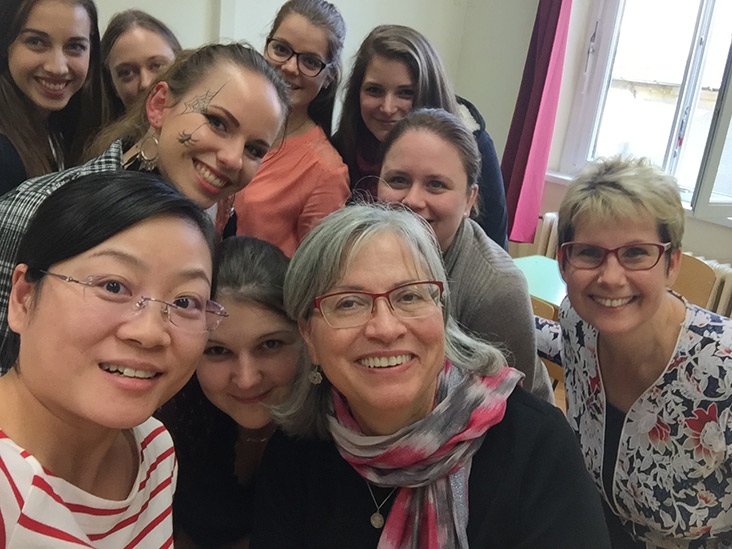Day in the Life: Tamara Gonzalez-Oberbeck

Tamara (center) spends retirement trotting across the globe for good.
Many people look forward to the end of their career as the chance to slow down from the daily grind of full-time work. Tamara Gonzalez-Oberbeck looked forward to retirement as her next big adventure.
After retiring from a career in nursing in the summer of 2016, Tamara strapped on a backpack to traverse Europe for a few months before beginning her Peace Corps service in Madagascar this past January.
Tamara is no stranger to life abroad; it seems fitting that she has chosen to bookend her career with Peace Corps work. Born and raised in Dayton, Ohio, she attended nursing school and specialized in ophthalmology. After graduating, she worked for the International Eye Foundation in Central America before her first stint with the Peace Corps as a medical officer in Nicaragua.
Upon coming back to the U.S., she worked as a school nurse at Jefferson Junior High in Columbia before getting the travel bug again. Soon after, she began serving as a U.S. Embassy nurse in Guatemala. She came back to Columbia and worked with Saving Sight, a Columbia-based nonprofit, as the KidSight program manager until retirement. Throughout her career, Tamara worked in Honduras, Nicaragua, Guatemala, St. Lucia, Barbados, El Salvador, Bolivia, Chile, and Panama. So she wasn’t going to stay put in retirement.
Backpacking through Europe
Tamara flew to Hungary on August 5, 2016, working on a budget of $30.00 per day. During her three months backpacking across Europe, she spent time in Hungary, Poland, Germany, the Netherlands, and Austria. She set up volunteer jobs through the groups World Wide Opportunities on Organic Farms, HelpX, and Workaway, and she volunteered as a farm worker, English teacher, and cook in several countries in exchange for room and board. As always, work was a key element of every day for Tamara, but there was always plenty of time to sight see. “It was a wonderful adventure of volunteering, meeting people, and getting lost in translation,” she says.
The idea to budget-backpack across Europe came to her through an article she read several years ago about a couple who took a similar trip. The couple wasn’t wealthy, but they were still able to enjoy a wonderful experience abroad, something that stuck with Tamara. “I decided I wanted to prove that: one, you do not have to have a lot of money to see the world; two, it is safe to travel the world alone; and three, even a 63-year-old can do this,” she says.
Some of her favorite moments came while spending time by the Baltic Sea in Poland, working in a Benedictine monastery with the resident monks, and meeting up with a German friend whom she met in Lisbon, where she took Portuguese lessons.
She flew back to Columbia over the holidays to spend time with friends and family, but she didn’t stay long — Madagascar awaited.
Serving the Peace Corps in Madagascar
Tamara began her 27-month commitment as a Peace Corps health volunteer in Madagascar in January. Located off the Eastern coast of Africa, Madagascar offers quite a different cultural experience than her European adventure. She went through three months of intense training on the island before moving to her official site, the small, rural village of Manadona, in May.
“In Manadona, I’m working with vaccines at a health clinic and teaching handwashing and nutrition throughout the villages nearby,” Tamara shares. “I plan to start a girl’s club, teaching English and encouraging girls to stay in school.”
The Peace Corps was founded in 1961 and has sent more than 225,000 volunteers to 141 countries in the name of national service. She also chose Madagascar for the chance to work with young girls and the diverse cultural experience the country offered. “Madagascar is so different from what I’ve experienced in Latin America,” she says. “The language is hard to learn, and no one speaks English.” Her love of lemurs, exotic animals, and flora also made Madagascar an exciting location to work and live.
During her training, she lived with a host family in the country, though she’s now in her permanent site in Manadona. There’s no running water or electricity. The bathroom options are an outhouse and a chamber pot. Tamara helps fetch water at the public well and brings it home to filter and clean for drinking. They wash all clothes by hand and can only take bucket baths with water heated on the stove.
They must cook daily and not waste the little food that’s prepared. (There are no options for refrigeration.) Most of their meals consist of rice, vegetables, and a little bit of meat or beans. The food culture causes Tamara to fondly recall past travel memories — you could say she’s used to it. “I remember writing a letter to my parents back in 1980, when I worked in Honduras,” Tamara says. “I wrote ‘Mom we eat beans and rice every day at every meal — every now and then they mix it up and serve rice and beans.’”
Tamara misses her host family, but she’s excited to be officially working on her health projects and girls’ education initiatives.
“So far, this journey has ignited my soul, and I look forward to the growth and insight I’ll reap from the experience,” Tamara says.
Continue following Tamara on her travels at mytimshel.wordpress.com.

A Typical Day at Peace Corps Training
5:00 a.m.: Wake with the roosters, pray, and stretch.
5:30 a.m.: Go out back to get water, heat it up, clean the chamber pot, and take a bucket bath.
6:30 a.m.: Put on rice to cook.
7:00 a.m.: Eat rice and homemade peanut butter. Make coffee on the stove.
7:45 a.m.: Walk to class for training and work.
12:00 p.m.: Walk home to fix lunch with leftover rice and beans.
1:00 p.m.: Rest and study until 2:00.
2:00 p.m.: Walk back to class for training and work.
6:30 p.m.: Eat dinner.
7:30 or 8:30 p.m.: Go to bed.


